Carex tonsa (Shaved Sedge)
| Also known as: | |
|---|---|
| Genus: | Carex |
| Family: | Cyperaceae (Sedge) |
| Life cycle: | perennial |
| Origin: | native |
| Habitat: | part shade, sun; moist to dry sandy or rocky soil; open woods, pine forest, rock outcrops, bluffs, sand prairies, sandy embankments |
| Fruiting season: | May - June |
| Plant height: | 1 to 6 inches |
| Wetland Indicator Status: | none |
| MN county distribution (click map to enlarge): |  |
| National distribution (click map to enlarge): |  |
Pick an image for a larger view. See the glossary for icon descriptions.
Detailed Information
Spikes: 

![[photo of spikes]](/udata/r9ndp23q/grass/carex-tonsa_0606_095438-t.jpg) Separate staminate (male) and pistillate (female) spikes, with a single staminate spike up to 12 mm (~½ inch) long at the tip of the stem. Just below the staminate spike is usually 1 pistillate spike (occasionally none, rarely 2), up to 7 mm (~¼ inch) long, stalkless or nearly so. There are also 1 or 2, short-stalked, all-pistillate spikes at the base of the stem.
Separate staminate (male) and pistillate (female) spikes, with a single staminate spike up to 12 mm (~½ inch) long at the tip of the stem. Just below the staminate spike is usually 1 pistillate spike (occasionally none, rarely 2), up to 7 mm (~¼ inch) long, stalkless or nearly so. There are also 1 or 2, short-stalked, all-pistillate spikes at the base of the stem.
![[photo of upper spikes and bract]](/udata/r9ndp23q/pd3/carex-tonsa-061716-15-t.jpg) At the base of lowest non-basal pistillate spike is a slender, bristle-like bract that does not overtop the terminal spike. Bracts of other pistillate spikes are shorter or obscure.
At the base of lowest non-basal pistillate spike is a slender, bristle-like bract that does not overtop the terminal spike. Bracts of other pistillate spikes are shorter or obscure.
Leaves and stems: 


![[photo of fibrous basal sheaths and rhizome]](/udata/r9ndp23q/grass/carex-tonsa_0614_081720-t.jpg) Leaves are basal and alternate, all near the base, .5 to 4.5 mm wide, erect to spreading, about as long as or longer than the flowering stem, with some old leaves persisting to the next season. The ligule (membrane where the leaf joins the sheath) is wider than long. Bases are wrapped in a reddish brown to purple sheath that becomes fibrous. Stems are erect to spreading, slender, 3-sided, rough along the angles. Stems may elongate up to 9 inches at maturity and usually remain shorter than the longest leaves. Plants form loose to dense clumps and may form mats from short, stout rhizomes.
Leaves are basal and alternate, all near the base, .5 to 4.5 mm wide, erect to spreading, about as long as or longer than the flowering stem, with some old leaves persisting to the next season. The ligule (membrane where the leaf joins the sheath) is wider than long. Bases are wrapped in a reddish brown to purple sheath that becomes fibrous. Stems are erect to spreading, slender, 3-sided, rough along the angles. Stems may elongate up to 9 inches at maturity and usually remain shorter than the longest leaves. Plants form loose to dense clumps and may form mats from short, stout rhizomes.
Fruit: 
![[photo of mature spikes]](/udata/r9ndp23q/grass/carex-tonsa-060317-1-t.jpg) Fruit develops in mid to late spring, the pistillate spikes forming clusters of seeds (achenes), each wrapped in a casing (perigynium), subtended by a scale. Each pistillate spike contains 2 to 12 fruits, the perigynia erect to ascending, overlapping and crowded on the spike.
Fruit develops in mid to late spring, the pistillate spikes forming clusters of seeds (achenes), each wrapped in a casing (perigynium), subtended by a scale. Each pistillate spike contains 2 to 12 fruits, the perigynia erect to ascending, overlapping and crowded on the spike.
![[photo of perigynia, scale and achene]](/udata/r9ndp23q/grass/carex-tonsa-616-2-t.jpg) Pistillate scales
are 2.9 to 4.1 mm long, egg-shaped to nearly triangular, pale to dark reddish-brown usually with narrow whitish edging, tapering to a pointed tip, lacking awns, and are as long as the perigynia or nearly so.
Perigynia
are 3.1 to 4.7 mm long, 1.1 to 1.6 mm wide, yellowish green to light brown at maturity, 2-ribbed, hairy on the upper body and beak or just a few hairs on the beak and along the ribs, the body round to elliptic in outline and round in cross-section, the base initially spongy but shriveling to a stalk-like structure (stipe), and abruptly tapering to a straight or slightly bent green beak 1 to 2 mm long that has 2 teeth at the tip.
Achenes
are 1.6 to 2 mm long, 1.2 to 1.6 mm wide, oval to urn-shaped in outline, weakly 3-sided in cross-section, and mature to brown.
Pistillate scales
are 2.9 to 4.1 mm long, egg-shaped to nearly triangular, pale to dark reddish-brown usually with narrow whitish edging, tapering to a pointed tip, lacking awns, and are as long as the perigynia or nearly so.
Perigynia
are 3.1 to 4.7 mm long, 1.1 to 1.6 mm wide, yellowish green to light brown at maturity, 2-ribbed, hairy on the upper body and beak or just a few hairs on the beak and along the ribs, the body round to elliptic in outline and round in cross-section, the base initially spongy but shriveling to a stalk-like structure (stipe), and abruptly tapering to a straight or slightly bent green beak 1 to 2 mm long that has 2 teeth at the tip.
Achenes
are 1.6 to 2 mm long, 1.2 to 1.6 mm wide, oval to urn-shaped in outline, weakly 3-sided in cross-section, and mature to brown.
Notes:
Carex tonsa is an occasional sedge primarily found in rocky forests, outcrops, and open, sandy soils and reaches the western edge of its US range in Minnesota. There are 2 recognized varieties, both of which are found in Minnesota: var. tonsa has perigynia nearly hairless, sparsely hairy only on the beak and 2 ribs, and relatively short, stiff, leathery leaves to 2.5 mm wide; var. rugosperma (formerly known as C. rugosperma) is the more common of the two and has perigynia sparsely to moderately hairy on the beak and upper body, with thinner, more flexible leaves up to 4.5 mm wide that are rough textured on the upper surface and usually much longer than the fruiting stems.
Carex is a large genus, with over 600 species in North America and 150+ in Minnesota alone. They are grouped into sections, the species in each group having common traits. Carex tonsa is in the Acrocystis section (formerly Montanae); some of its common traits are: mostly dry habitat, hairless leaves, basal sheaths typically fibrous, small spikes often tightly clustered, terminal spike staminate, perigynia typically hairy, perigynia with 2 small teeth at the tip of the beak, achenes 3-sided to round in cross-section.
Carex tonsa is distinguished by the combination of: clump-forming, red basal sheaths that become fibrous, single terminal staminate spike, pistillate spikes at the plant base, the lowest non-basal pistillate spike with a bristle-like bract that does not overtop the terminal spike, pistillate scales as long as the perigynia, usually hairy perigynia up to 4.5 mm long with a round to elliptic body and straight to slightly bent beak 1 to 2 mm long.
Carex tonsa is one of a group of 4 members of Acrocystis that have pistillate spikes at the base, the others are Carex rossii, Carex deflexa, and Carex umbellata. Of these 4, C. tonsa and C. umbellata both have slender, bristle-like bracts at the base of the lowest non-basal spike that do not overtop the terminal spike plus pistillate scales about as long as the perigynia, where the other two have leaf-like bracts that overtop the terminal spike and scales shorter than the perigynia. C. umbellata perigynia are smaller than C. tonsa, not more than 3.2 mm long with a shorter beak only .4 to 1 mm long.
Of note is the county distribution map, showing it present in a number of counties but with no records in the Bell Herbarium—we have no explanation for that, except perhaps some specimens labeled as C. umbellata might actually be C. tonsa, or perhaps the missing C. tonsa records are all in another herbarium. The C. tonsa-umbellata complex can be confusing and is apparently under review. Maybe a revision will make everything more clear.
Native Plant Nurseries, Restoration and Landscaping Services ↓
More photos
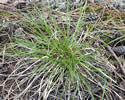 Carex tonsa plant
Carex tonsa plant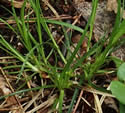 Carex tonsa plant
Carex tonsa plant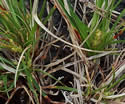 Carex tonsa plant
Carex tonsa plant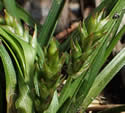 Carex tonsa plant
Carex tonsa plant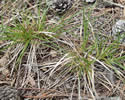 Carex tonsa plants
Carex tonsa plants mature basal spikes
mature basal spikes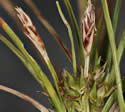 lacking pistillate spikes below the staminate spike
lacking pistillate spikes below the staminate spike
Photos by K. Chayka taken in Pine County. Photos by Peter M. Dziuk taken in Anoka and Lake counties.
Comments
Have you seen this plant in Minnesota, or have any other comments about it?






